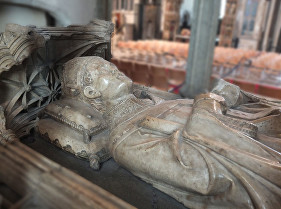Basics
Geology: an evaporite deposit (hydrated calcium sulphate)
Most common rock unit: Mercia Mudstone Group
Age: Middle-Upper Triassic
Most common provenance: Chellaston, Derbyshire
Where to see examples
Archbishop Stratford (died 1348)
Lady Mohun (died 1390)
Archbishop Courtenay (died 1396)
Henry IV and his wife Joan (died respectively 1413 and 1437)
James Hales (died 1589)
William Prude (died 1632)
James Beaney (died 1891)
Edward Youde (died 1986)
Description
Alabaster is a fine-grained, translucent, ornamental form of gypsum. At various times in geological history thick beds of gypsum have formed by the evaporation of sea water. Alabaster, free from impurities, is a snow-white stone but frequently iron-rich clays are present in the desiccating waters and a red-brown coloration results sometimes producing veining in the stone. Otherwise pure alabaster has a translucent appearance with a fine sugar-like texture and takes a good polish.
Most of the alabaster used to construct medieval monuments was quarried, or mined, since the early fourteenth century from Chellaston in Derbyshire and Tutbury in Staffordshire. Chellaston was the larger producer of monumental stone during the Middle Ages and the stone was transported to Nottingham for carving and, for the more prestigious commissions, such as royal tombs, alabaster was despatched to the large London workshops. Alabaster is a very soft material and could therefore be easily and speedily carved by the alabastermen. The first alabaster monuments exploited the pure white stone nearer the surface. It is said that it was not until the sixteenth century that coloured varieties became acceptable and mining was extended to greater depths to extract the red veined beds.
The next major phase of using alabaster for monumental masonry was during the 19th and 20th centuries when further mines opened to extract the Chellaston gypsum. The smaller monumental and ornamental commissions were undertaken at Chellaston while much stone was transported to Derby for carving. Mines also produced gypsum for the manufacture of plaster and cement as well as agricultural products. The Chellaston gypsum industry finally closed in 1937.

